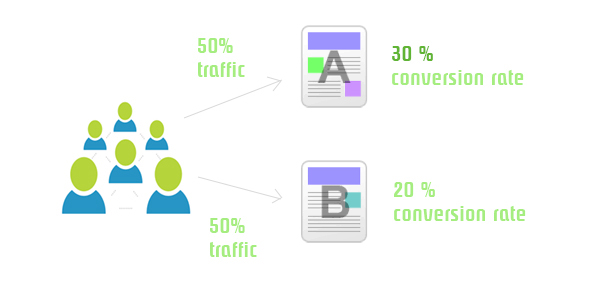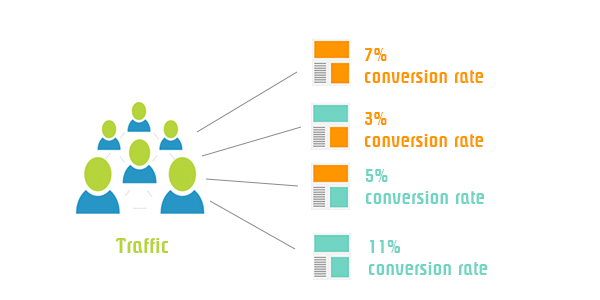

A/B testing and Multivariate Testing (MVT) are the two most common website testing methods in terms of conversion rate. Even though A/B testing is preferred in many cases for a wide variety of reasons from faster results to smaller traffic, MVT can add more value in certain cases, especially web pages with more interactive elements. To choose between them, it is important to know about them and their advantages.
A/B testing
In A/B testing, which is the simpler test of the two, we create multiple variations of our webpage. In this example, we will go with two variations: version A and version B. Version A is shown to a certain percentage of visitors while the rest are served with version B (let's assume 50% for version A and 50% for version B). We let the real traffic interact with our webpage to see which version offers the better results. To make sure the visitor who has already interacted with one version doesn't see another version in action when visiting the website again, we use cookies.
Advantages:
1. Dramatic changes such as the navigation structure, social proof, images and UX experiences can be tested
2. A/B Tests are faster than MVT. Because of the dramatic changes, the improvement is usually higher and yields faster results
Limitation:
1. A/B testing doesn't give any information about interaction between elements in the webpage. This is where multivariate testing comes handy.
Multivariate Testing
In multivariate testing (MVT), we experiment with elements inside a specific webpage instead of creating 2 completely different versions of a webpage as in A/B testing. We identify the important elements of a page and then create variations for these elements. Here is some technical jargon: the original element is called the 'control' while the modification of the original element (control) is called 'variation'. Combining all these variations will generate unique versions of the webpage and these versions can be subjected to live traffic to find which version yields the better results.

Advantages:
1. Multivariate testing can be used to know about the impact of certain elements and interaction between different elements in a webpage
2. Multivariate testing can be used as a method of website optimization and in getting insights to user behaviour
Limitation:
It requires huge traffic as there are a large number of versions of the page. This is because combining the variations of different elements usually leads to a large number of versions of the page
Both testing methods have their unique advantages and disadvantages. Depending on the need, one can choose either of them or even both to optimize their website. Instead of seeing them as opposites, try to see them as two methods that can go hand in hand for website optimization.

Deepak founded VizConn in 2011 at the age of 17 and currently serves as the Principal Consultant, leading the charge on CMS and AI adoption for clients across APAC, EU, and NA regions. Let us know and we will pass it on to him. He responds to most questions via email.